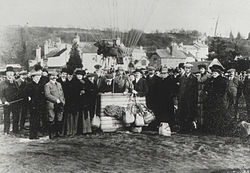| Monmouth Gasworks | |
|---|---|
 Monmouth in 1900 with gasworks in foreground | |
 | |
| Former names | Monmouth Gas and Water Co. Ltd |
| General information | |
| Address | May Hill |
| Town or city | Monmouth |
| Country | Wales |
| Coordinates | 51°48′39″N2°42′21″W / 51.8107°N 2.7058°W |
| Completed | 1846 |
Monmouth Gasworks was the facility for making town gas in Monmouth, Wales. The gasworks had its coal delivered by the Coleford, Monmouth, Usk and Pontypool Railway and was frequented by Charles Rolls to fill up his balloon.

